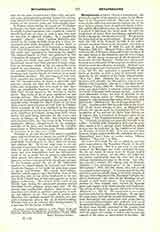

Metaphrastes, SYMEON (Sumeon o metaphrastes), the principal compiler of the legends of saints in the Menologia of the Byzantine Church. Through the importance of this collection his name has become one of the most famous among those of medieval Greek writers. The epithet Metaphrastes may be rendered Compiler; it is given to him from the usual name for such arrangements of saints’ lives (metaphrasis, compilation). Little is known for certain about his life. His period is the latter half of the tenth century. In one of his legends (the Life of St. Samson) he tells of the saint’s miracles continued down to his own time; that time is the reign of Romanos II (959-63) and of John I Tzimiskes (969-76). Michael Psellos (1018-78), who wrote the life of Symeon, afterwards added to those of the other saints in the collection, says he was a Logothete. In this case it means one of the Secretaries of State with the title Magister. Psellus also tells us that Symeon was a favorite of the emperor, at whose command he made his collection of legends. Ehrhard says that this emperor was Constantine VII (Porphyrogennetos, 912-59) who organized a compilation of all kinds of learning to form a kind of universal encyclopaedia by the scholars of his Court (Krumbacher, “Byz. Lit.”, 200). Ehrhard (loc. cit.) and most authorities now identify the Metaphrast with Symeon Magister the Logothete, who wrote a chronicle under Nicephorus Phocas (963-9). Besides the identity of name and period there is internal evidence from the two works (Chronicle and Legends) for this. A certain Arab chronicler, Yahya ibn Said of Antioch, in the eleventh century refers to “Simon, Secretary and Logothete, who composed the stories of the saints and their feasts” (Delehaye in “Revue des questions hist.”, X, 84). Another point that fixes his time as the latter half of the tenth century is that, as Ehrhard has proved, the speech made by Constantine VII at the translation of the portrait of Christ from Edessa on August 16, 944, is contained in Symeon’s part of the Menology (“Die Legendensammlung”, etc., pp. 48, 73). Formerly his period was generally thought to be earlier. In his life of St. Theoctistus of Lesbos he gives what seems to be a passage about himself, in which he says that he took part in the expedition of Admiral Himerios to Crete in 902. It is now proved that Symeon simply copied all this life, including the auto-biographical note, from an earlier writer, Niketas (Ehrhard, “Byz. Lit.”, p. 200).
Symeon’s chief work, the one to which he owes his great reputation in the Byzantine Church, is the collection of Legends. But it is not easy to say how much of the Menology was really composed by him. On the one hand, in many cases he simply copied existing lives of saints; on the other, the collection has grown considerably since his time and all of it without discrimination goes by his name. Leo Allatius (op. cit.) ascribes 122 legends only to Symeon, Delehaye (“Les Les menologes grecs” in the “Analecta Bollandiana”, XVI, 311-29), thinks that 148 or 150 are authentic and original. It may be noticed that the authentic ones are chiefly those in the early months of the year, from September (the Byzantine Calendar begins in September; the saints in the Menology are arranged as their feasts occur). It is certain, that a number of these legends were written by Symeon from such sources as he found (partly oral tradition). The sifting of these from the rest still needs to be done (Ehrhard, 1. c., 201-2). His reputation as an author has been restored by the latest students. At one time his name was a byword for absurd fabrications. Ehrhard, Dobschutz, and others have now shown him to be a conscientious compiler who made the best use of his material that he could. The often absurd stories in his lives were already contained in the sources from which he wrote them; he is not responsible for these, since his object was simply to collect and arrange the legends of the saints as they existed in his time. He has often been compared to the great Western compiler of legends, Jacobus de Voragine (d. 1298). Some (Kondakoff, “Histoire de l’art byzantin,” Paris, 1886, I, 46) prefer Symeon of the two. His legends were translated into Latin by Lippomanus, “Vita ss. priscorum patrum” (Venice, vols. V-VII, 1556-1558). Supposing the identity of the Metaphrast and Symeon Magister, we have other works by him, a Chronicle not extant in its original form, but altered and supplemented in the Chronicle that goes by his name, in the Corpus of Bonn (Theophanes continuatus, Bonn, 1828, 603-760), reprinted in P.G., CIX, 663-822; also an Epitome of Canons (P.G., CXIV, 236-292), collections of maxims from St. Basil (P.G., XXXII, 1116-1381) and Macarius of Egypt (P.G., XXXIV, 841-965), some prayers and poems (P.G., CXIV, 209-225) and nine letters (P.G., CXIV, 282-236). Symeon Metaphrastes is a saint in the Orthodox Church. His feast is November 28.
ADRIAN FORTESCUE

